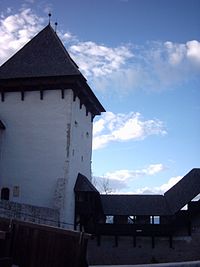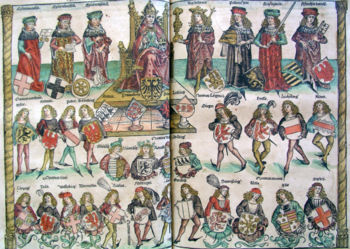- Counts of Celje
-
The Counts of Cilli[1] or Celje (Slovene: Celjski grofje; German: Grafen von Cilli; Hungarian: cillei grófok) represent the most important medieval aristocratic and ruling house with roots and territory in present-day Slovenia.
At the time the house died out they held the rank of princes of the Holy Roman Empire and many other titles in territories of present-day Central Europe.
Contents
Name and origins
The name "Counts of Cilli" was given to the Lords of Sanneck or Sannegg by Emperor Louis IV in 1341 and was derived from the medieval name Cilli of the city of Celje in Lower Styria. Celje itself became a property of the dynasty in 1333.[2] and in a short period of time they owned more than 20 castles all over the territory of modern Slovenia and beyond through the marriages of their daughters.
Habsburg's allies
In the 14th century they allied with the Habsburgs in their war against the counts of Gorizia- Tirol, making Cilli vassals of the Habsburgs in 1308. [3] With their acquiring large estates in the adjoining duchies of Styria, Carinthia,and Carniola as well as in the territories of the Hungarian crown (Croatia, Slavonia) their influence rose and they became one of the most powerful families in the area. They were related by marriage with rulers of Bosnia and Polish and Hungarian kings.[4]
Savior of the king
Their rapid rise started after the Battle of Nicopolis (1396) where the Croatian ban Hermann II of Cilli saved the life of Sigismund of Luxemburg (Hungarian king, from 1433 Holy Roman emperor). As a reward king Sigismund donated (1397-99) the city of Varaždin, the county of Zagorje, and many estates in Croatia to the family.[5] The House of Cilli and Sigismund became even closer through the marriage of Hermann's daughter Barbara of Cilli to king Sigismund.[6] In 1436 the Emperor elevated the counts to the rank of princes of the Holy Roman Empire (although they retained their title of Count, in German: Graf,in Slovene: grof). The Habsburgs, whose strongest rivals they had become, reacted with a war that lasted until 1443, when an agreement of mutual inheritance was signed.[7]
Keeper of the young king
Ulrich II of Cilli was the most powerful member of the Cilli family. He held a large influence in many courts, which originated from the relationships the Cilli family had made in the past. He tried to get regency of Hungary, Bohemia and Austria through control over Ladislas the Posthumous, at the time a minor. With such ambitions he got many opponents and rivals, such as the Hunyadi family. After an unsuccessful claim to the Bosnian crown, Cilli obtained some territories in Croatia and Slavonia and finally succeeded in forcing Frederick III, Holy Roman Emperor to hand over (1452) the boy king Ladislas the Posthumous to his keeping. Thus, Ulrich II became practically the ruler of Hungary. In 1456 after the death of his rival John Hunyadi, Ulrich II was named Captain General of Hungary, an office previously held by John Hunyadi. That initiated a plot by the Hunyadi family against Ulrich II, and he was assassinated on 8 November, in Belgrade.
Murder in Belgrade
With the death of Ulrich II the male line of the Counts of Cilli died out, and after a war of succession all of their estates and property were handed over to the Habsburgs on the basis of the inheritance agreement.
Legacy
Part of their coat of arms - the three golden stars on a blue background, which, as Lords of Sanneck, they had inherited from the once powerful Carinthian Counts of Heunburg upon their becoming extinct in 1322 - was incorporated into the Slovenian coat of arms in 1991. It is also the current coat of arms of Celje. In addition, all European monarchs descended from Christian IX of Denmark and his wife, Louise of Hesse-Kassel (a direct matrilineal descendant of Barbara of Celje) are descended from the family.
-
Royal Yugoslav coat of arms (1918–45), with three golden stars representing Slovenes
The Lords of Sanneck or Barons of Soune, Counts of Cilli
The Lords of Sanneck (Žovnek) or Barons of Soune [8]
- Gebhard (ca. 1130–1144)
- Gebhard II (1173–1227)
- Conrad I († ca. 1255)
- Ulrich I († ca. 1265)
- Ulrich II († ca. 1316)
- Frederick I († 1360), from 1341 Count of Celje
Counts of Cilli (Celje)[9]
- Herman I († 1385), wife Katarina Kotromanić
- William († 1392), wife Ana of Poland, daughter Anna of Cilli († 1416)
- Herman II († 1435), daughter Barbara of Cilli († 1451)
- Frederick II († 1454), 1.wife Elizabeth Frankopan, 2. wife Veronika of Desenice
- Ulrich II († 1456), wife Katarina Branković
References
- ^ The house should be referred to in English by the original historic name "of Cilli", although the name "of Celje" is also used nowadays.http://genealogy.euweb.cz/small/cilli.html
- ^ Enciklopedija Slovenije II, 1988, f. 13 COBISS 17411
- ^ Enciklopedija Slovenije II, 1988, f. 13 COBISS 17411
- ^ Enciklopedija Slovenije II, 1988, f. 14 COBISS 17411
- ^ Enciklopedija Slovenije II, 1988, f. 13 COBISS 17411
- ^ Enciklopedija Slovenije II, 1988, f. 13 COBISS 17411
- ^ Enciklopedija Slovenije II, 1988, f. 14 COBISS 17411
- ^ Enciklopedija Slovenije II, 1988, f. 14 COBISS 17411
- ^ Enciklopedija Slovenije II, 1988, f. 14 COBISS 17411
Slovenstvo grofov Celjskih, 1937 (dr. Dragan Šanda)
External links
Categories:
Wikimedia Foundation. 2010.









